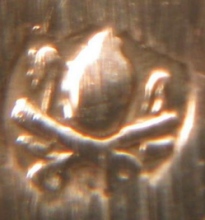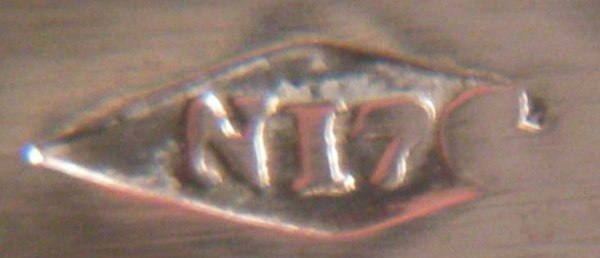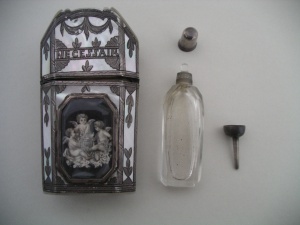 newsletter # 24 April 2006
newsletter # 24 April 2006www.ASCASonline.org
email: silverassociation@yahoo.it
YOUR GUIDE TO APRIL NEWSLETTER: new articles new members members' window questions replies a page per month what is this piece? two years of ASCAS contributors to April Newsletter search engine disclaimer and privacy policy
|

Giorgio Busetto presents: Three unusual silver cups Since ancient times silver cups were used as drinking vessels, for religious services or decorative purposes. In this article are illustrated three 20th century cups that may be interesting for ASCAS readers, not for their (little) value, but for their unusual shape and their uncommon employ. click here |

Martine D'Haeseleer presents: Belgian Art Deco silver A review of Belgian silversmiths of the 20th century click here |
Internal Search Engine
A new 'tool' for ASCAS members.The 'Internal Search Engine' supplied by "google" offers a quick find of the matter of your interest inside ASCAS website
New members
Welcome to new ASCAS members:
Pierluigi Bosio - Italy
Stephan Chinchilla - France
John Crosskey - England UK
Nona De Grote - Belgium
Stephen C. Dube - USA
Michelle Ford - England UK
Mustapha Harti - Morocco
Maurice Kirman - New Zealand
Bernie Lechman - USA
Judi Lechman - USA
Debra Lewis - USA
Francine Martello - USA
Kathryn B. Walter - USA
Joanne Wiertella - USA
Paulina Wojdak - Poland
Members' Window # 24
 Attilio Porsia presents: An inkstand from the "Regno delle Due Sicilie" Un calamaio dal Regno delle Due Sicilie an inkstand with dolphins' garniture made in Palermo (Sicily) at the beginning of the 19th century This article is available in two versions English |
Questions from ASCAS members
Les Salvage writes:
...... I am showing here, a butter knife, the haft of which is dented and makes it difficult
to photograph in detail. The knife has hallmarks - crown for Sheffield, lion passant and gothic
letter "l" (lower case L), all in rectangles with cut-off corners signifying 1903. These
hallmarks are on both sides of the haft indicating I presume, that the haft was made in two
halves and then joined together. It will be noted that the blade is of electroplate. The makers
initials are HH&S.
I would like to know more about this item if anyone has some knowledge that is not already
apparent.
Obviously, it is not valuable, but nevertheless, I think it worth asking about.
Regards
Les Salvage
Nikica Vuletic writes
.....I am sending you a scan image of an oval silver (I hope so) tray. It weights approx. 800 grams
and brings hallmark that I tried hard to identify. It is nice lobster (or crayfish) and number 1
can be read. I surfed lot of books and web pages but with no result.
Best Regards!
Nikica Vuletic
P-G Beghin writes:
... I send the photos of a wine taster:
high 24 mm, diameter 79 mm, tickness 2 mm, weight 125 gr.
The bowl's edge is inscribed 'D CHAUSSARD DORVILLE' followed by three marks
two other marks on the base
handle in the shape of a snake with two other marks
This wine taster belongs to the family of my wife from three generations.
Her grand-grand-grandmother's name was Jeanne Chaussard, borne at Orville (France) in 1810.
Jeanne's father name was Edmé, so we think that this wine taster belonged to a more ancient
relative.
I hope you may help me to learn more about the origin of this object.
Best regards.
P-G Beghin
Emanuele Felicioni writes:
... I believe that this silver cup was made by German silversmith Christoph Jamnitzer (hallmark
cjb: Christoph Jamnitzer Burg). I'd greatly appreciate ASCAS members' help in identifying these
hallmarks and supplying more information about the maker.
Best regards.
Emanuele Felicioni

|

|

|

|

|

|

|

|

|
Christoph Jamnitzer of Nuremberg (1563-1618), grandson of the
foremost German goldsmith Wenzel Jamnitzer (1597 ?-1585), is recorded as a silver worker,
draughtsman and engraver. He became a master goldsmith in 1592 having probably been
apprenticed to the Nuremberg workshop of Hans Pezolt.
Only twenty-five of his works of art in silver survive, most of them in public
collections.

|

|
portrait of Christoph Jamnitzer |
Christoph Jamnitzer 's signature, mark and date of becoming master |


|
Replies to members' questions
|
Tom Guarrera writes about
'Topos '
article published in March Newsletter: ...Just received the new newsletter and I was very excited to see the article on topos. I've quickly taken a photo of the few I own in case you'd like to add more examples to the article ... Forgot to mention, I've heard them referred to as 'topos', but more often 'tupos'... |
Another addition to Wayne Robbins question about his Samuel
Pemberton needle case
(February Newsletter). Attilio Porsia writes:
... on past Newletters I've read the question about Samuel Pemberton's etui. I have a
similar piece, made in silver with mother of pearl inserts and a miniature on its body.
The interior, in red velvet lining, contains a crystal bottle (crystal lid and silver cover)
and a tiny scent funnel.
Dimensions:
bottle: 60 X 10 mm
box; 83 mm high, base 42 x 20 mm, top 45 x 25 mm,
On the lid's sides the inscriptions: "NECESSAIR" and "DE TOILETT"
Age (assumed): second half of the 18th century
"A page per month"
in this new column we present a page (one page only) obtained by makers' brochures, books, auction catalogs or whatever other printed paper,
that may be of particular interest for ASCAS members.
The images will be published at a "low resolution" level and for private and personal use only
This month ASCAS presents the images of ancient silversmith's tools
from Planche V 'Outils' of L'Encyclopèdie Diderot & D'Alambert. The table is coupled
to the corresponding 'legend' containing the French name of each tool.I'm unable to offer a proper English translation of this page but any help by ASCAS members would be interesting and welcome.
Giorgio Busetto

|

|
HISTORICAL DESCRIPTION OF THE ENCYCLOPEDIE (from American and French
Research on the Treasury of the French Language: ARTFL Project)
The Encyclopédie ou Dictionnaire raisonné des sciences, des arts et des métiers, par une
Société de Gens de lettres was published under the direction of Diderot, with 17 volumes of
text and 11 volumes of plates between 1751 and 1772. Contributors included the most prominent
philosophes: Voltaire, Rousseau, d’Alembert, Marmontel, d’Holbach and Turgot, to name only a few.
These great minds (and some lesser ones) collaborated in the goal of assembling and disseminating
in clear, accessible prose the fruits of accumulated knowledge and learning. Containing 72,000
articles written by more than 140 contributors, the Encyclopédie was a massive reference work for
the arts and sciences, as well as a machine de guerre which served to propagate Enlightened ideas.
Due to problems of censorship, successive volumes of the Encyclopédie appeared at an irregular
pace. The first seven volumes were issued, one per year, from 1751 to 1757. Distribution of the
ten remaining volumes took place in 1766. The volumes of plates, relatively unaffected by
censorship, were released at the rate of roughly one per year from 1761-1772. In its original
printing, about 4,000 copies were made. The impact of the Encyclopédie was enormous, not only in
its original edition, but also in multiple reprintings in smaller formats and in later
adaptations. It was hailed, and also persecuted, as the sum of modern knowledge, as the a
monument to the progress of reason in the eighteenth century. Through its attempt to classify
learning and to open all domains of human activity to its readers, the Encyclopédie gave
expression to many of the most important intellectual and social developments of its time.
THE PLATES
The Encyclopédie contains 2,569 plates, grouped by theme, in 11 volumes. The original folio
edition includes a mix of single-page, and double-, triple-, and quadruple-page images. Legends
precede each group of plates. Individual plates frequently contain multiple figures, usually in
combination with references numbers or characters that coordinate with the text of the legends.
What is this piece ???
This month ASCAS presents two " Mystery items"
Mary Clarke writes:
I wonder if any of the members can help me identify the following two objects which I recently
acquired?
They originated from a Moravian Mission Station in South Africa and have apparently been
around since the early 1800's. I have approached the two major auction houses here and it has
been suggested that the item with the two-tined 'fork' might be a wine opener. The two tines
are laterally flattened steel, while the handle is unmarked silver around horn.
Attached to the horn are what appear to be two bunches of grapes on either side. It is 20cm
long.
The second item has a pointed ridged steel (such as might be used to sharpen a knife)case which
is removable to reveal a split steel prong. The handle is again unmarked silver with an acorn
finial. 21cm in length.
The auctioneers and one specialist silver dealer here all thought they might be 18thC Dutch,
but were unsure of their uses. Can anyone help please?
Thank you
Mary Clarke
David Berman writes:
We are looking for information on an unusual piece we recently acquired, and believe you may
be the expert to help us out!.
Attached please find two photographs of this strange item. Our first research led us to believe this may have been a brandy warmer, based upon its similar size, and the fact that the
cup would be very much like cups found on antique brandy warmers.
Yet, there is no pouring spout on the cup as seems to be most common for brandy warmers.
The size of the solid cup is comparable to that of a shot glass. However, the puzzling part is
this: the handle appears to be sized and constructed very much like that of a pipe, complete
with a pipe tip or mouthpiece! More puzzling yet is the fact that at the bottom of this 'pipe
handle' there is a small vent hole, that is flush with and exits from the bottom of the 'pipe
handle', but not in any way is this vented to the cup!
We cannot figure for what strange purpose this item might be for, or why someone would need to
blow or inhale through the pipe stem (which isn't connected to the cup).
This piece appears to be sterling silver, with hallmarks of a castle, 'W', and a crown stamped
on the bottom.
Any thoughts as to the purpose, origin, and history or this strange item would be most
appreciated!!
David Berman
Any help would be greatly appreciated
Two years of ASCAS
ASCAS was founded on April 8 2004

Best wishes to ASCAS for its second Birthday and .... Good Luck !!!

|
Closing our April 2006 edition of ASCAS
Newsletter I hope you have appreciated its content.
Your comments, suggestions and advice will be of great help.
My thanks to P-G Beghin (France), David Berman (USA), Lars Björkman (Sweden), Mary Clarke
(South Africa), Martine D'Haeseleer (Belgium/Spain), Jayne Dye (USA), Emanuele Felicioni (Italy), Tom Guarrera
(USA), Giorgio Guida (Italy), Attilio Porsia (Italy), Les Salvage (USA), Nikica Vuletic
(Croatia), for their invaluable contributions.
Giorgio Busetto
Secretary
ASCAS is a community of people having a common interest in
antique silver.
|






































